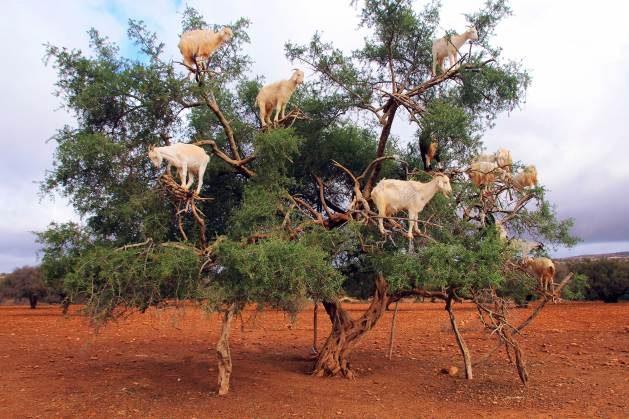A Short Tale of a Tree, a Bottle of Oil, and a Moroccan Wedding Party
TRANSCEND MEMBERS, 22 May 2023
Baher Kamal | Human Wrongs Watch - TRANSCEND Media Service
12 May 2023 – A much needed break amidst so many alarming news, with a brief story of a tree, a bottle of liquid gold, and a wedding gift.

The argan tree forest constitutes a vital fodder reserve for all herds even in periods of drought. All parts of the argan tree are edible and very appreciated: leaves, fruits and the undergrowth are a meal of choice especially for the most daring goats that do not hesitate to climb the branches. Credit: Shutterstock.
It is useless to remind you that all trees are wonderful living beings, with an amazing vital system to drain water through their roots, and breathe through their leaves to bring this water to their trunk, branches and leaves.
All of them are sources of most of the oxygen on Earth while absorbing harmful greenhouse gases. Their roots greatly contribute to fixing the land, thus reducing the risk of further degradation and desertification. Let alone purifying the air.
This particular tree
Among them, one is special: the Argan tree.
A native species of the sub-Saharan, Southwest region of Morocco, where it grows in arid and semi-arid areas, this tree is the defining species of a woodland ecosystem, also known as Arganeraie, which is rich in endemic flora.
The argan tree used to grow throughout North Africa, but currently, it only grows in southwestern Morocco. It is estimated to be the second most abundant tree in Moroccan forests, with over 20 million trees living in the region.
The argan tree is one of the world’s wild plants, which are used by an estimated 3.5 to 5.8 billion people, with one billion humans depending on them for their livelihoods and food security.
Furthermore, wild plants offer great economic and nutritional benefits for these communities and for societies around the world. In fact, between 2000 and 2020, the global trade value of medicinal and aromatic plants alone increased by more than 75%, as reported by the UN Food and Agriculture Organization (FAO).
In spite of that, two in five of the world’s plant species are at risk of extinction due to habitat loss, sustainable use and climate change.
Hidden in plain sight
Here is the case of just one of these wild plant species hidden in plain sight:
Argan can be found in cosmetics, food and pharmaceuticals. Mostly used as an oil, its anti-ageing properties are popular for cosmetics, and its demand in the food industry has turned it into the most expensive edible oil in the world, FAO adds.
Under the burning sun
Now see what the UN further tells about its importance on the occasion of this year’s International Day of Argania:
- It withstands temperatures of up to 50° Celsius.
- It is a bastion against desertification, it can reach 10 metres in height and can live for 200 years.
- Its woodlands provide forest products, fruits and fodder.
- Its leaves and fruits are edible and highly appreciated, as is the undergrowth, and constitute a vital fodder reserve for all herds, even in periods of drought.
- It is used as fuelwood for cooking and heating.
- And also as medicines and cosmetics.
A mainstay of indigenous Berbers
For centuries, the argan tree has been a mainstay of the Berber and Arab-origin indigenous rural communities, which developed a specific culture and identity, sharing their traditional knowledge and skills through non-formal education, particularly the knowledge associated with the traditional production of argan oil by women, the world body explains.
The argan-based agro-forestry-pastoral system uses only locally adapted species and pastoralism activities and relies on traditional water management provided by the Matifiya – a rainwater reservoir carved into the rock, hence contributing to climate change mitigation and adaptation, and to the conservation of biodiversity.
The ‘liquid gold’
But there is more: the world-renowned argan oil, which is extracted from the seeds and has multiple applications, especially in traditional and complementary medicine and in the culinary and cosmetic industries.
In addition, argan oil is given as a wedding gift and it is used extensively in the preparation of festive dishes.
The fruit of the argan tree is a green to light yellow berry in the centre of which is an almond made up of several seeds gorged with oil. It takes about 150 kg of fruit to produce 3 litres of argan oil.
The Argan Women
Indeed, it is said that, since the 13th century, the Berber women of North Africa have been making argan oil for culinary and cosmetic purposes.
The International Day of Argania further explains that the fruits are hand-picked and dried in the sun, then pulped, grinding, sorting, milling and mixing. Its nuts are crushed and its almonds crushed to filter the oil.
Women lead the entire extraction process through knowledge transmitted from one generation to the next. In fact, rural women and, to a lesser extent, men living in the reserve practice traditional methods to extract argan oil from the fruit of the tree.
“Traditional know-how specific to the extraction of the oil and its multiple uses is systematically transmitted by ‘argan women’, who teach their daughters from a young age to put it into practice.”
What else would you expect from a tree?
_____________________________________________
 Baher Kamal, a member of the TRANSCEND Network for Peace Development Environment, is an Egyptian-born, Spanish national, secular journalist, with over 45 years of professional experience — from reporter to special envoy to chief editor of national dailies and an international news agency. Baher is former Senior Advisor to the Director General of the international news agency IPS (Inter Press Service) and he also contributed to prestigious magazines such as TRANSCEND Media Service, GEO, Muy Interesante, and Natura, Spain. He is also publisher and editor of Human Wrongs Watch.
Baher Kamal, a member of the TRANSCEND Network for Peace Development Environment, is an Egyptian-born, Spanish national, secular journalist, with over 45 years of professional experience — from reporter to special envoy to chief editor of national dailies and an international news agency. Baher is former Senior Advisor to the Director General of the international news agency IPS (Inter Press Service) and he also contributed to prestigious magazines such as TRANSCEND Media Service, GEO, Muy Interesante, and Natura, Spain. He is also publisher and editor of Human Wrongs Watch.
Go to Original – human-wrongs-watch.net
DISCLAIMER: The statements, views and opinions expressed in pieces republished here are solely those of the authors and do not necessarily represent those of TMS. In accordance with title 17 U.S.C. section 107, this material is distributed without profit to those who have expressed a prior interest in receiving the included information for research and educational purposes. TMS has no affiliation whatsoever with the originator of this article nor is TMS endorsed or sponsored by the originator. “GO TO ORIGINAL” links are provided as a convenience to our readers and allow for verification of authenticity. However, as originating pages are often updated by their originating host sites, the versions posted may not match the versions our readers view when clicking the “GO TO ORIGINAL” links. This site contains copyrighted material the use of which has not always been specifically authorized by the copyright owner. We are making such material available in our efforts to advance understanding of environmental, political, human rights, economic, democracy, scientific, and social justice issues, etc. We believe this constitutes a ‘fair use’ of any such copyrighted material as provided for in section 107 of the US Copyright Law. In accordance with Title 17 U.S.C. Section 107, the material on this site is distributed without profit to those who have expressed a prior interest in receiving the included information for research and educational purposes. For more information go to: http://www.law.cornell.edu/uscode/17/107.shtml. If you wish to use copyrighted material from this site for purposes of your own that go beyond ‘fair use’, you must obtain permission from the copyright owner.